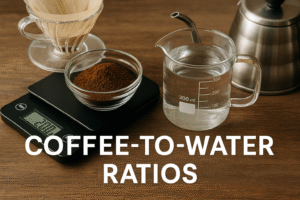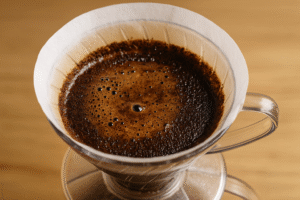If your coffee tastes too bitter, too sour, or just not quite right, the problem might not be your beans or water—it could be the grind size. Understanding how grind size affects extraction is one of the most powerful tools for improving your coffee at home.
Each brewing method requires a specific grind to match the time the coffee is in contact with water. Getting this right enhances the flavor, mouthfeel, and balance of your drink.
In this detailed guide, we’ll explore how to choose the right grind size for each brewing method, what tools you need to achieve it, and how to troubleshoot problems caused by incorrect grinding.
What Is Grind Size, and Why Does It Matter?
Grind size refers to how coarse or fine your ground coffee is. This affects the surface area of the coffee exposed to water during brewing.
The general rule:
- Coarse grind = slower extraction
- Fine grind = faster extraction
Using the wrong size throws off the balance. Too coarse? Water passes too quickly and under-extracts, resulting in sour, weak coffee. Too fine? The water extracts too much, leading to bitterness.
Types of Coffee Grinds by Texture
Let’s compare grind sizes to common kitchen items for reference:
- Extra Coarse – Like rock salt (for cold brew)
- Coarse – Like sea salt (for French press)
- Medium-Coarse – Rough sand (for Chemex)
- Medium – Regular sand (for drip brewers)
- Medium-Fine – Table salt (for AeroPress, pour-over)
- Fine – Slightly finer than sugar (for espresso)
- Extra Fine – Like powdered sugar (for Turkish coffee)
Using a burr grinder is essential for consistency. Blade grinders create uneven particles, leading to over- and under-extraction in the same brew.
Grind Size for Popular Brewing Methods
Here’s a breakdown of ideal grind sizes by method:
1. Cold Brew
Grind: Extra Coarse
Why: Steeping time is long (12–24 hours), so large particles prevent over-extraction
Tip: Strain twice to avoid grit in your drink
2. French Press
Grind: Coarse
Why: Immersion method with 4-minute steeping; large grounds prevent clogging
Tip: Stir gently before pressing to prevent floating crusts
3. Chemex
Grind: Medium-Coarse
Why: Thick filters and slow draw-down require slower flow
Tip: Pour water in circular motions to saturate evenly
4. Drip Coffee Maker
Grind: Medium
Why: Consistent with most automatic filter coffee machines
Tip: Check brew time—ideally 4–6 minutes
5. Pour-Over (V60, Kalita Wave)
Grind: Medium-Fine
Why: Faster brew, needs slightly finer grind for full extraction
Tip: Adjust depending on filter thickness and speed of flow
6. AeroPress
Grind: Fine to Medium-Fine
Why: Short contact time, and pressure helps extract more quickly
Tip: Inverted method allows more flexibility with steep time
7. Espresso
Grind: Fine
Why: 25–30 seconds under pressure; fine grind is essential for crema and strength
Tip: Dial in the grind daily for best results
8. Turkish Coffee
Grind: Extra Fine
Why: Brewed without filtration, requires dust-fine particles
Tip: Let the grounds settle before sipping
How to Test and Adjust Grind Size
If you’re unsure about your grind, start with the recommended setting and taste your coffee. Adjust based on the following feedback:
- Sour, acidic, watery? → Grind finer
- Bitter, dry, harsh? → Grind coarser
- Too fast brew? → Grind finer or tamp harder (if using espresso)
- Too slow brew? → Grind coarser or reduce dose
Use a timer to track how long your brew takes. If a pour-over finishes in under 2 minutes, you likely need a finer grind.
Why Consistency Matters
Even if you use the right size, inconsistent grind particles lead to uneven extraction. Burr grinders crush beans between surfaces for uniform results.
Blade grinders chop randomly, creating a mix of fine powder and large chunks—making it nearly impossible to get a balanced cup.
Investing in a good burr grinder is one of the best upgrades you can make for home brewing.
Tips for Choosing the Right Grinder
- Manual burr grinders are affordable and portable
- Electric burr grinders offer speed and precision
- Flat burrs produce consistent grind size
- Conical burrs are quieter and easier to clean
Avoid grinders that don’t let you adjust the size manually.
How to Maintain Your Grinder
Over time, oils and dust from the beans build up inside your grinder. Dirty burrs can affect taste and even damage the machine.
To keep it clean:
- Brush burrs weekly
- Deep clean monthly with grinder cleaner pellets or uncooked rice (if safe for your model)
- Avoid using flavored beans, which cause more residue
Frequently Asked Questions (FAQs)
1. Can I use one grind size for all methods?
Not ideally. Each method has different flow rates and times. Use at least two settings if switching methods.
2. How do I know if my grinder is good enough?
If it produces consistent particles, lets you adjust settings, and doesn’t heat the coffee while grinding, you’re on the right track.
3. Is it better to grind right before brewing?
Yes! Ground coffee begins losing flavor within minutes. Always grind fresh.
4. Are pre-ground beans bad?
They’re not ideal. Even if sealed, they quickly lose aroma and go stale. For best results, grind your own.
5. Why does my espresso pull unevenly?
Likely due to inconsistent grind or channeling. Tamp evenly and ensure the grounds are fine enough.
6. Can I use a spice grinder for coffee?
Not recommended. The blades are designed for dry spices, and the result is uneven. You’ll likely get both dust and chunks.
7. How much should I spend on a grinder?
Manual burr grinders start around $40. Electric burr grinders range from $80 to $300+. Invest according to your brewing habits.
Final Thoughts – Grinding Toward Perfection
Grind size is the foundation of good coffee. You can have the best beans in the world, but if they’re ground incorrectly, you won’t get their full potential.
Start by learning the right size for your brew method. Then fine-tune by taste, timing, and texture. Keep your grinder clean, your beans fresh, and your brews consistent.
Once you master the grind, everything else starts falling into place. And your coffee? It gets way, way better.

Marcio Luzardo is a coffee enthusiast and the voice behind Tudo Viraliza. With a passion for turning curiosity into practical knowledge, he shares easy-to-follow tips, guides, and insights to help readers enjoy better coffee every day. When he’s not writing, Marcio is exploring new brewing methods or diving into the rich stories that connect coffee to culture, lifestyle, and wellness.



